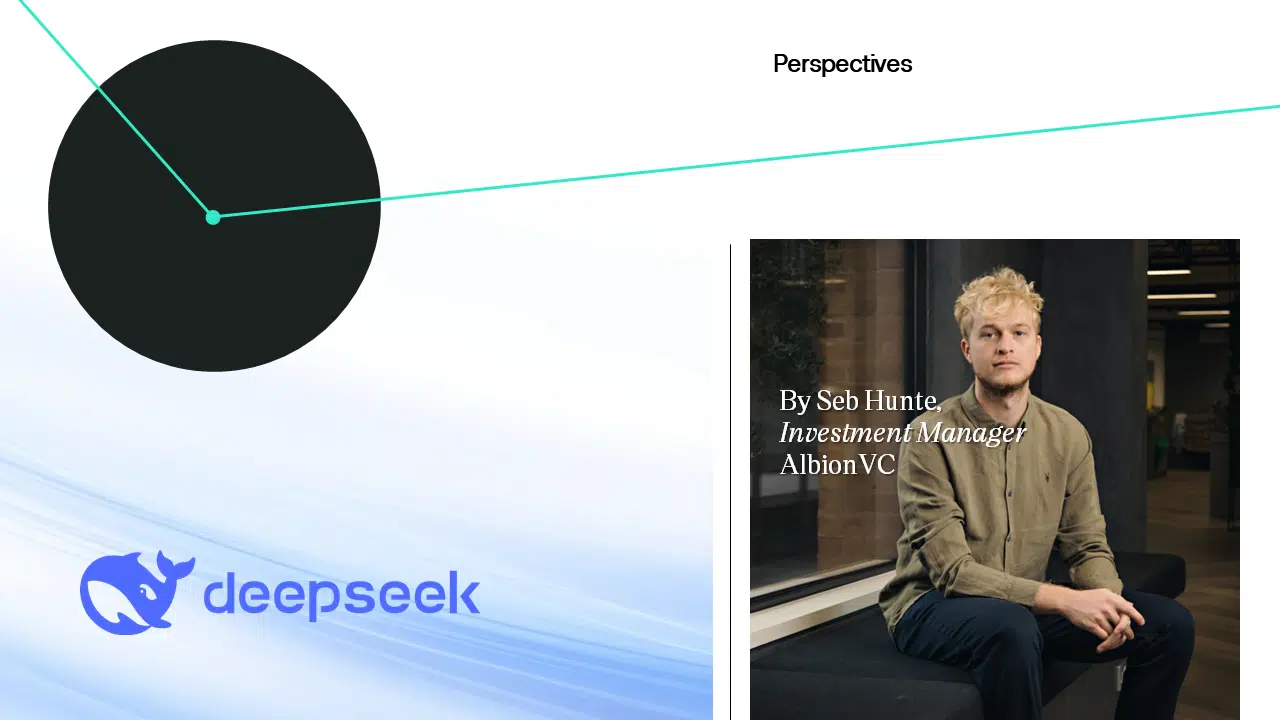DeepSeek Implications for UK/EU VC Ecosystem
By Sebastian Hunte, Investment Manager
Chinese startup DeepSeek has created a Sputnik moment, sending stock markets, big tech, and the venture capital community into a spin.
A lot has been written on the subject, from the implications of US export controls and the lack of easy venture capital funding accelerating Chinese innovation to OpenAI’s potential responses and DeepSeek’s popularity with Western consumers. In this post, we consider the implications of the DeepSeek effect for the UK tech ecosystem and how the AI VC landscape is evolving in response.
Technical Innovation Enables Performance and Cost Advantages
DeepSeek released its V3 model, introducing multiple breakthroughs that challenge traditional cost structures in AI.
DeepSeek has reportedly developed its model for approximately $5.6 million in training costs, a fraction of the hundreds of millions spent by its Western counterparts. While exact training costs remain debated (this doesn’t include research costs etc.), the model’s demonstrated capabilities and efficiency gains are undeniable.
DeepSeek Innovations
- Multi-Head Latent Attention (MLA): Reduces Key-Value (KV) cache size, improving inference speed and lowering memory use.
- Mixture-of-Experts (MoE) with Auxiliary-Loss-Free Load Balancing: Optimizes expert distribution, eliminating token-dropping and ensuring all tokens contribute to learning.
- Multi-Token Prediction (MTP): Predicts multiple tokens in a single step, improving fluency and reducing computation time.
- FP8 Mixed-Precision Training: Reduces memory and computation costs while maintaining precision, making AI more cost-effective.
- DualPipe for Efficient Pipeline Parallelism: Reduces idle GPU time and optimizes hardware utilization.
Continuous Evolution of LLMs and Market Adoption
Jevons’s Paradox suggests that greater efficiency drives increased usage rather than reduced consumption. Cost-effective AI models like DeepSeek-V3 accelerate adoption, competition, and replication.
DeepSeek’s rapid rise to the top of the Apple Store downloads exemplifies this trend. However, this also raises concerns: if incumbents see their innovations swiftly replicated, will they continue investing in groundbreaking R&D? Over time, this could shift the focus from transformative breakthroughs to incremental improvements.
To maintain long-term differentiation, AI companies must move beyond raw performance, developing proprietary datasets, domain expertise, and defensible market positioning.
Competitive Position and Strategic Considerations
Is Big Tech Safe in the Post-V3 World?
Major cloud providers like Amazon, Google, and Microsoft still stand to gain as AI adoption grows. However, for companies solely focused on foundation models, the challenge is stark:
- Next-gen AI firms like OpenAI, Anthropic, and Mistral must optimize system-level performance rather than just model capabilities.
- Greater emphasis on specialized hardware architectures could emerge as a competitive differentiator.
- The API-based business model may need to evolve as open-source alternatives become more sophisticated.
Data Security and Geopolitics
DeepSeek raises questions about data provenance and need for high-end hardware. Australia has already banned its use on government devices over security risks, and other nations may follow suit. However, with proper isolation—such as local model deployment—these security concerns can be mitigated while retaining performance and cost advantages.
Core Implications for UK Startups and VCs
Lower Barriers to Entry and Capital Efficiency
Cheaper AI deployment enables UK startups to integrate AI without incurring high cloud or GPU costs, benefiting lean but technically strong European startups.
The Space for Innovative New-Comers outside of Silicon Valley
The rise of DeepSeek has demonstrated that with smart innovation, researchers and entrepreneurs can build globally competitive AI models at significantly lower costs. This hopefully serves as an inspiration for EU and UK developers to create state-of-the-art models today and leverage their expertise to develop category-defining application-level companies of the future.
Transformation of the Competitive Landscape
Lower inference costs open up new AI applications in verticals such as law, consulting, robotics, and edge devices. Rapid, iterative product development gains an edge over heavy capital investments.
Defensibility Through Execution
With foundation models becoming commodities, competitive advantage hinges on execution, customer ownership, and brand strength rather than proprietary AI algorithms alone.
Observations from Investor Perspectives
Emerging VC Market Trends
Major funds are segmenting the market into x verticals, many of which were previously services-focused (e.g., consulting, law, etc.), making aggressive bets on category leaders and doubling down until dominant players emerge. This aligns with the idea that AI-driven markets exhibit steeper power law outcomes.
Early-stage and later-stage investments can often be more attractive than Series A rounds.
Investors frequently achieve better outcomes by either backing an exceptional team at the Seed stage and continuing to support them as they scale or waiting until Series B or C when clear market winners emerge and strong brands are established.
AI-first products can grow quickly due to enterprise interest and consumer adoption, but retention remains a challenge. As foundational models improve, the technical moat for application-layer companies shrinks, making execution the key differentiator.
Investors can take two approaches:
- Bet on an outstanding team at Seed that can iterate rapidly and scale efficiently, ensuring they “fill the holes in their bucket” (improve retention) faster than customers churn.
- Wait until Series B or later when retention metrics provide clarity and valuations better reflect actual de-risking.
Series A companies often scale quickly but still struggle with retention, making valuations at this stage less correlated with true market defensibility. In such cases, investing before or after this inflection point may be more prudent.
Looking Ahead
The AI industry is shifting towards efficiency innovations. Companies integrating cost-effective AI with strong execution will define the next generation of industry leaders.
For investors, this means prioritizing firms that can turn AI accessibility into market dominance, ensuring long-term success in an increasingly competitive landscape.
The AI race is far from over—but with DeepSeek’s approach, the rules of the game may be changing faster than we anticipated.
Other news
Can AI data pains lead to photonics business opportunities? | BI Foresight
AlbionVC partner Dave Grimm on why now is the time for photonics chips to shine
AlbionVC: London still outpaces Paris in tech | UKTN
Ed Lascelles, AlbionVC Partner shares insights on the State of European Tech: Why London Still Leads
